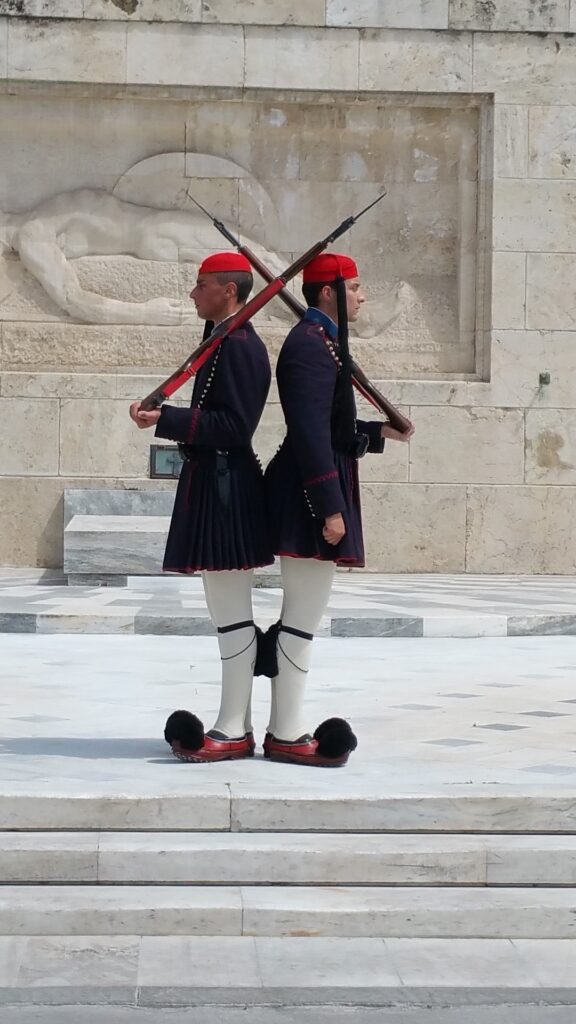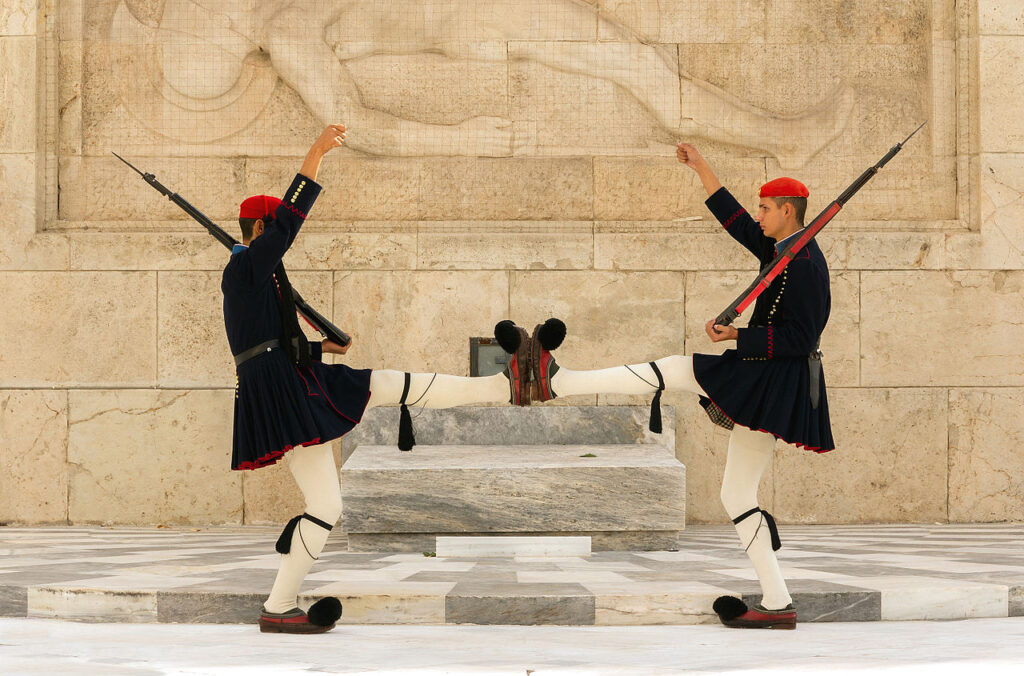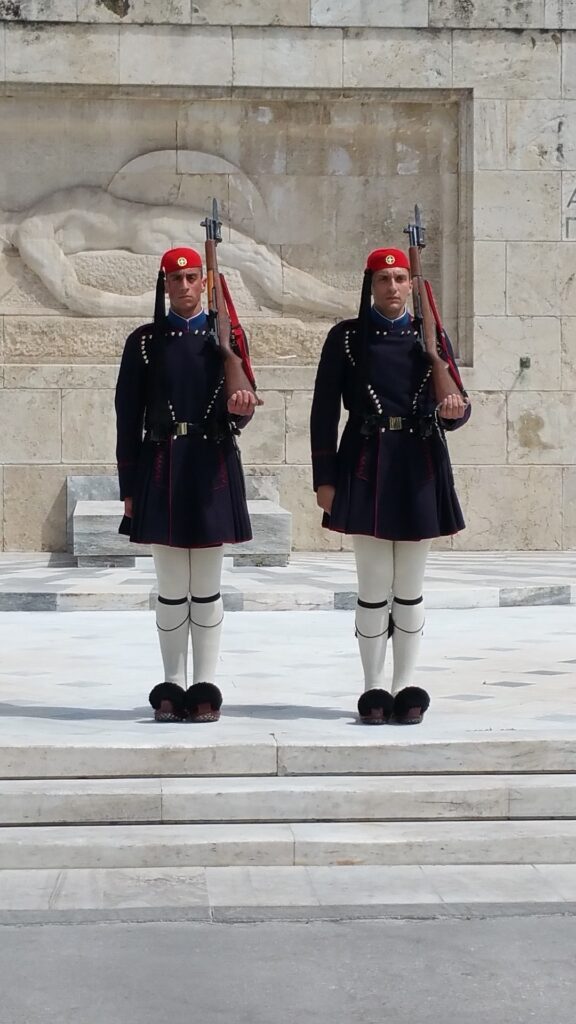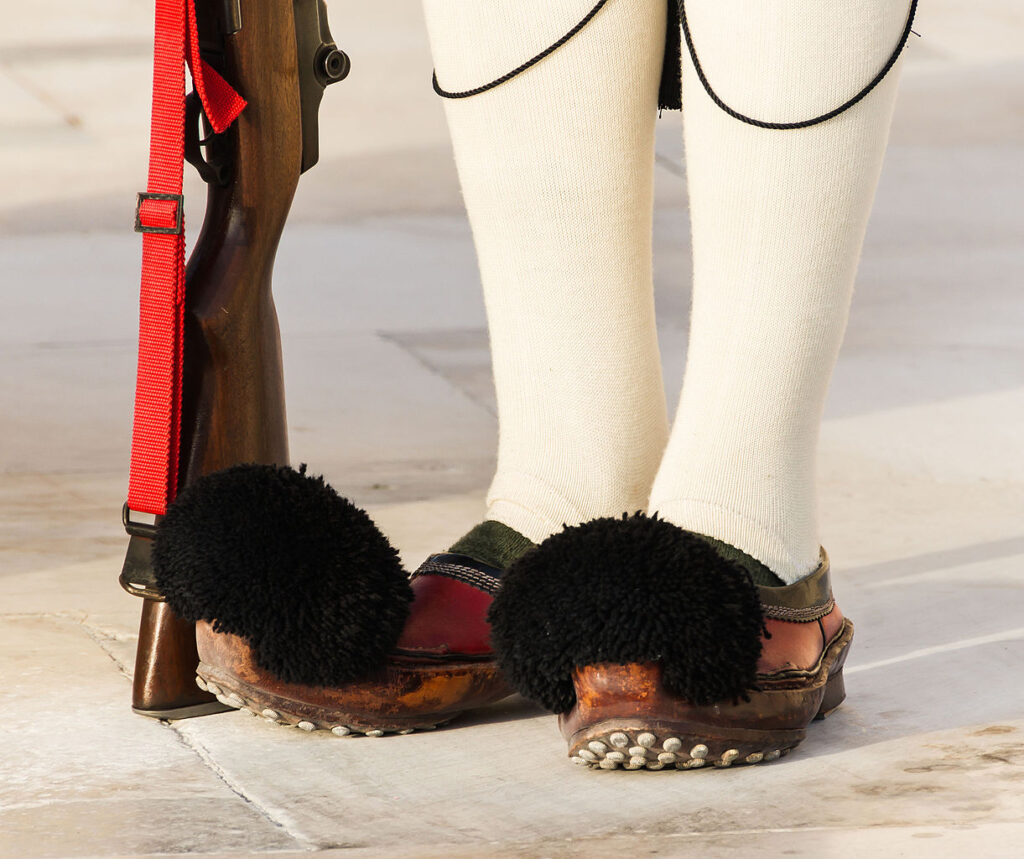The Evzones , Greece’s Presidential Guard
Introduction
The Greek Presidential Guard or Evzones are a group of elite Greek soldiers who are trained to perform various ceremonial duties. They stand guard at the Tomb of the Unknown Soldier and the Presidential Palace and also raise and lower the flag at the Acropolis every Sunday. The Evzones uniform is handmade with intricate detail, taking many months to complete and is a symbol of the country’s nationalistic pride, representing the significant battles fought throughout Greece’s modern history. The formal version of the uniform is white and worn on Sundays and at official occasions, with a doulama or tunic worn at other times, khaki in summer and navy blue in winter. After the Parthenon, they are probably the second most photographed sight in Athens; every day visitors from around the world stand before them posing for selfies, admiring their fine features and wondering aloud about their “dresses”.

Etymology
The first mention of the word “Evzone” (or back then, the Ancient Greek term was “evzonoi”) can be traced to Ancient Greece. However, back then, the word didn’t refer to a uniform of any kind. The word first appears in Homer’s Iliad and is an adjective that means “well-belted.” Literally, it was a reference to an “elite man” and not necessarily a soldier of any kind. Now, the word simply refers to the soldiers whose purpose it is to guard the Tomb of the Unknown Soldier. It can also reference the traditional uniform itself.
Video – Changing of the guard
Tsolias – Colloquial Word for the Evzone Soldier
Evzone isn’t the only word that is used to describe the soldiers themselves. As a side note, Evzone soldiers are often referred to as Tsolias colloquially. However, the term “Tsolias” is usually reserved for members of Greece’s modern military. Though, these soldiers could take on the ceremonial duties, such as becoming a member of the Presidential Guard. In that case, they would become “Evzones” and would wear the traditional Evzone uniform.

Background of Evzones’ Uniform
After the Greek War for Independence concluded, King Otto of Bavaria became King of Greece. Though it lasted for thirty years, his reign was a turbulent one. He was never fully embraced by the Greek people, especially since he and his wife were considered outsiders. During this time, even the Evzone’s manner of dress underwent some changes. In 1833, a Bavarian-inspired Evzone uniform was introduced. It featured blue trousers, a tailcoat, and a shako, a type of military helmet. It was changed in 1837 to something that more closely resembles today’s uniform.
Contemporary duties
The Presidential Guard is naturally not involved in any fighting activities, although up to WW II, it was regarded the strongest and bravest part of the Greek army. Their uniform is a
reproduction of the outfit proudly worn by guerrilla fighters during the Ottoman Occupation of Greece (1453 – 1821). Nowadays, young men doing their army duty are hand-picked for the
Presidential guard according to specific categories such as height (they have to be over 1,87 meters– 6,13 feet), character, moral outlook and good health, general appearance and stamina.
Those who join the corps, first complete five and a half months of their basic military training and then receive one month of specific training as Presidential Guard, which they serve for the following five months. The notoriously tough specific t raining involves the development of the ability to stand still for an hour and the perfecting of their trademark synchronized ceremonial gait when changing guard.

The Presidential guard has the following duties:
- on a 24 hour bases, guarding the Tomb of the Unknown Soldier, the Presidential Mansion and the gates of the Presidential Guard training camp.
- the official raising and lowering of the flag (at 9am and 6pm respectively) every Sunday at the Acropolis.
- accompanying the President of the Republic on official foreign visits .
- offering honors and welcoming foreign officials on visit .
- an annual parade on New York’s 5th Av . in celebration of Greece’s 25 March Independence Day

Changing of the guard
Every Sunday at 1 1:00, tourists gather in front of the Parliament building on Syntagma Square (Plateia Syntagmatos) to watch the ceremonial changing of the guard in front of the Tomb of the Unknown Soldier. The guards (Evzones) wear their traditional white kilts, red and black caps and red clogs with pompoms only that d ay or on special occasions. On every other day, the
Evzones wear regular khaki uniforms with skirts and the changing of the guard takes place every hour on the hour, 24 hours a day. The guards are tall and well-trained soldiers. They
belong to the “Proedriki Froura”, the guards of the President of Democracy. It is a high honor for every Greek soldier to be chosen as an Evzone.
Each soldier mounts guard for one hour at a stretch, 3 times every 48 hours. They work in pairs in order to perfect the coordination of their movements. Originally founded as a royal guard in 1868, this elite corps has a bout 120 members and enjoys much better accommodations and conditions than the typical Greek army conscript. Much seen and photographed by international tourists and local visitors alike, the ‘tall guys’ guarding the Tomb of the Unknown Soldier and the parliament (Vouli) are famous in their own right.
The Evzone Uniform of Today
Today’s Evzone uniform is complicated. It has around twelve parts, and each needs to be in place. The Evzones form the Presidential Guard, a prestigious discipline for the soldiers. Their main function is to guard the Tomb of the Unknown Soldier but they also march in official parades, as well. Note that there are also some differences depending on which part of Greece the uniform originated. The uniforms (there are several kinds) are all hand-made at the tailor’ s department of the Presidential Guard training camp. There, some ten individuals, skilled in hand-embroidery and machine sewing, painstaking prepare the uniforms over long periods of time. The Evzones waistcoat alone takes up to one month to sew. World-famous ‘tsarouchi’ shoes are also manufactured at the camp’s shoe-making department by three to four men trained in the craft. Each tsarouchi, a leather clog with black pompoms, weighs 1,5 kilogram and has sixty nails studded into the soles so that the Evzones don’t slip

The uniform is highly symbolic and it can change slightly at different times of the year. In addition to the typical Evzone uniform, they could wear the traditional Cretan Evzone dress and Ponti Evzone uniform. The Cretan design doesn’t include a foustanella, but rather dark blue trousers. The soldiers often wear different uniforms to honor different aspects of Greek military history. The skirt/kilt is called a ‘fustanella’ in Greek. There are 400 pleats in it; one for each year of the Turkish occupation. The Evzones have professional steam irons in the barracks and they have to iron them themselves. The uniforms are made by special craftsman in workshops within the barracks and take 80 days to make. Officers wear an older more elaborate form of the uniform and since the Second World War, Evzones from Crete wear blue breeches and caps with white boots.

The main parts of the Evzone uniform are:
- the hat made of red baize with a silk tassel
- the shirt, white with very wide sleeves
- the waistcoat, hand embroidered with great skill. Various designs of great traditional and folklore importance are embroidered on the waistcoat in white or gilt thread
- the kilt (foustanella) made from 30 meters of white material with 400 pleats representing the 400 years of the Turkish occupation
- the breeches, the long red trousers of the officers and the white woolen stockings of the Evzones
- the cartridge belt
- the garters, black for the Evzones and blue for the officers.

Apart from the above which are common to both Evzones and officers, there are also
- the gaiters, the red boots and the 1821 sabre of the officers
- the inside garter, which holds the stockings in position
- the fringe (blue and white colored braids, the colors of the Greek flag)
- the “tsarouchia”, the traditional shoes of the Evzones.










